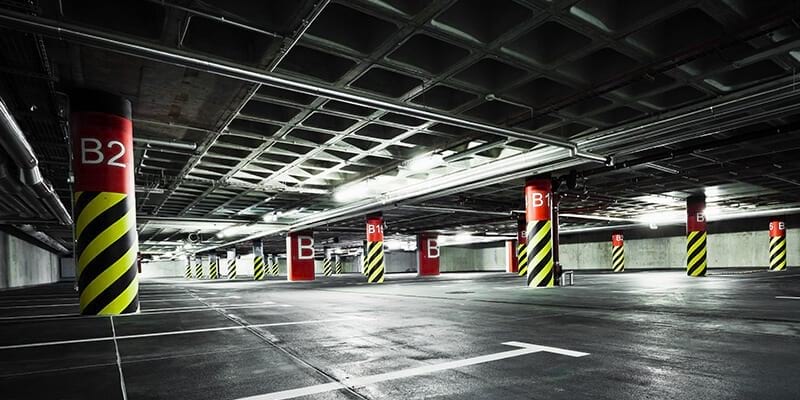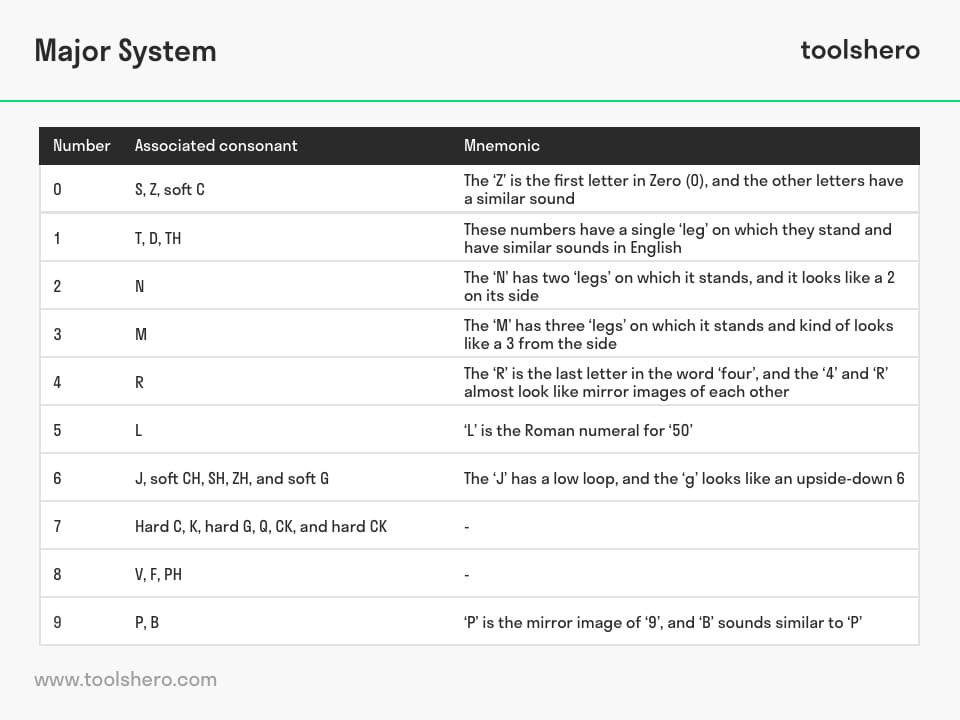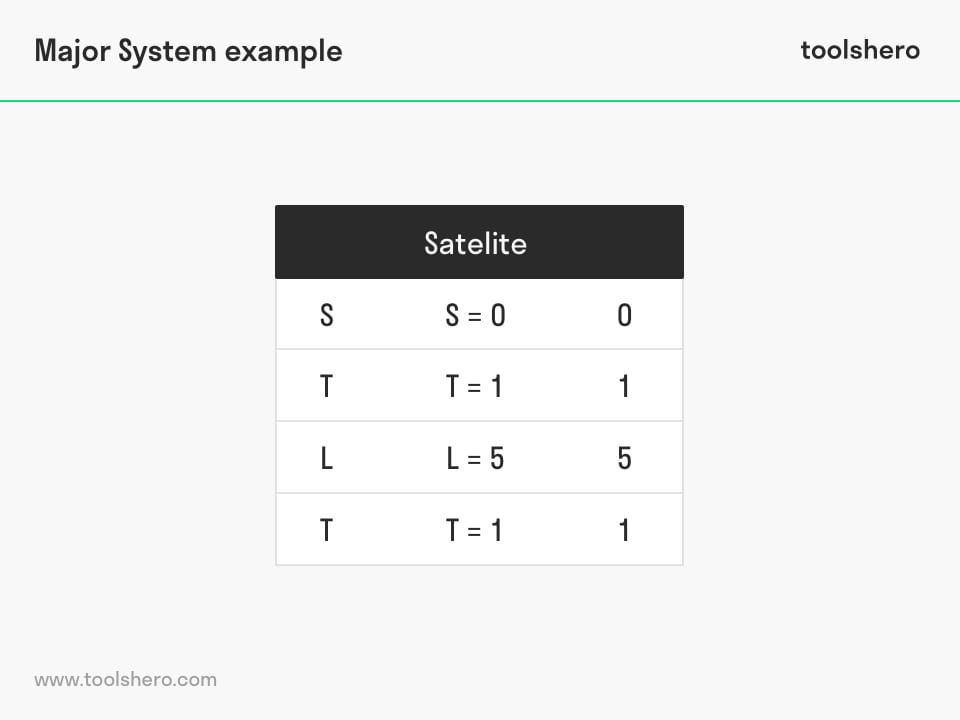Mnemonic Major System

Mnemonic Major System: this article provides a practical explanation of the Mnemonic Major System. Next to what it is, this article also highlights how you can use it, a practical Mnemonic Major System example and the Evolution. After reading, you’ll understand the basics of this powerful personal development and memory tool. Enjoy reading!
What is the Mnemonic Major System?
Definition
The Mnemonic Major System is a mnemonic technique and device that makes it easier to remember series of numbers.
It’s also a phonetic number system, converting numbers into consonant sounds and then into words by adding vowels. According to mnemonic principles, it’s easier to remember images than numbers. The Major System is based on that idea.
It was likely named after the 19th-century Polish military advisor and major Beniowski. Living in exile in England, he was an activist for radical organisations. Multiple inventors have been linked to the Major System, and several versions have been seen in recent centuries.
For example, it has been attributed to the French photography and mnemonic device expert Francis Fauvel Gourand.
Later in the 20th century, it was popularised by the American magician, mentalist, and memory trainer Harry Lorayne. German historian Johann Just Winckelmann is also regularly mentioned of the Major System in the late 17th century.
How do you use a mnemonic major system?
The Mnemonic Major System is a so-called mnemonic technique. It’s a memory trick and phonetic mnemonic system that helps people to easily remember a lot of information simultaneously. Examples are dates, long series of numbers, new people’s faces, shopping lists, or big chunks of text.
It’s based on the idea that information with no structure or a complicated one can be remembered by associating them to an alternative structure.
When he parks his car in spot F-1 in a car park as large as a football pitch, chances are the driver won’t manage to easily find it again.
When spot F-1 actually has a picture of basket of Fruit (starting with the letter F), that image and the combination of the letter and the number will be remembered by the driver, helping him to easily find their car again.
There are many more mnemonic devices in addition to the Major System, with the Memory Palace being one of the most famous. By talking a virtual stroll through, for instance, your own home, you can remember objects or long series of numbers.
The first series of decimals of an infinite number like pi can be remembered and reproduced in that way; 3.1415926535 8979323846 2643383279 5028841971 6939937510 …. The person who has to remembered is asked to visualise the front door and see the number 314 on it.
The entry hall has a balloon hanging in it with 159 written on it. The little cabinet under the mirror has a wooden frame on it displaying the number 265. The door to the sitting room has 358 painted on it. By memorising all these numbers and associating them with objects in the memory palace, it becomes easier to reproduce them.
Using a language method based on rhythm and music is a common mnemonic device as well. Using a rhyme or song is a good way to remember things.
To remember our solar system, you can use My Very Excited Mother Just Served Us Nine Pies for example, referring to Mercury, Venus, Earth, Mars, Jupiter, Saturn, Uranus, Neptune, and Pluto. ‘ROYGBIV’ is a similar acronym to remember the order of the colours of the rainbow: Red, Orange, Yellow, Green, Blue, Indigo, Violet.
Mnemonic Major System example
This mnemonic assigns certain sounds to certain numbers. In its most common form, it ignores vowels. They can be used as fillers to create recognisable words. Each number refers to a series of similar sounds with similar positions of the mouth and tongue. The link is phonetical; it’s about the consonant sounds and not the actual spelling.
This way, the Major System as a term memory makes it easy to remember numbers, such as different kinds of codes, dates, credit card numbers, and phone numbers. The most common definition is as follows:

Figure 1 – Major System
In addition to what has been listed above, it’s good to remember that vowels, double letters, and the letters W, H, Y, and X are not used. The following example shows what number can be remembered using the word ‘Satellite’:

Figure 2 – Major System Example
The full code for ‘Satellite’ would then be ‘0151’.
Evolution
You can use images that show that contain the exact number of consonants in the number. Consonants can also be used as a general guideline, with a combination of additional consonants.
As long as it’s logical to the user, and he knows the link between the numbers and words, it doesn’t really matter how the letter combination looks.
The current word list of the Major System has 60,000 words, divided over about 25,000 codes. Over the centuries, the system has evolved, and each number is usually associated with one or more consonants.
It’s also possible to create mnemonic images, for which it’s recommended to use at least one set image for each number between 0-9 and 00-99. Another way to use the system is to form sentences with different words, reproducing them like a mantra or rhyme.
Now it’s your turn
What do you think? Do you recognize the explanation of the Mnemonic Major System? Do you use the Major System to make it easier to remember things? Do you have any tips or additions you would like to share regarding memory techniques?
Share your experience and knowledge in the comments box below.
More information
- Bellezza, F. S. (1983). Mnemonic-device instruction with adults. In Cognitive strategy research (pp. 51-73). Springer, New York, NY.
- Bower, G. H. (1970). Analysis of a mnemonic device: Modern psychology uncovers the powerful components of an ancient system for improving memory. American Scientist, 58(5), 496-510.
- McCarty, D. L. (1980). Investigation of a visual imagery mnemonic device for acquiring face–name associations. Journal of Experimental Psychology: Human Learning and Memory, 6(2), 145.
How to cite this article:
Mulder, P. (2019). Mnemonic Major System. Retrieved [insert date] from Toolshero: https://www.toolshero.com/personal-development/mnemonic-major-system/
Published on: 10/10/2019 | Last update: 08/15/2023
Add a link to this page on your website:
<a href=”https://www.toolshero.com/personal-development/mnemonic-major-system/”>Toolshero: Mnemonic Major System</a>












